Mid-season cucumber variety "Competitor" with good yield and simple growing conditions
Cucumbers are a symbol of the end of the vitamin deficiency season. The first zelents from local gardens appear on the markets in the second half of May.
From a huge number of varieties and hybrids, many choose a proven cucumber with a telling name Competitor. This variety has been present on the domestic market for over 40 years. During this time, he not only has not lost its popularity, but also successfully competes with more modern achievements in breeding. What is the competitor's secret of success - read on.
The content of the article
Description of the variety of cucumbers
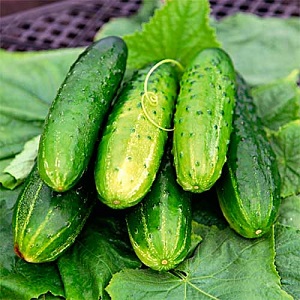 The competitor is a cucumber variety bred by Crimean breeders back in the time of the USSR.
The competitor is a cucumber variety bred by Crimean breeders back in the time of the USSR.
It was entered into the state register in 1980.
The variety was originally recommended for cultivation in the southern regions. However, farmers assure that the Competitor bears fruit well in the open field and in regions with a temperate climate.
Suitable for growing seeds harvested from fruits on your own site... The cucumbers are allowed to ripen, outgrow and turn yellow on the bush. Seeds are carefully removed from them, washed from the pulp, dried and stored in fabric bags in a dark place.
Distinctive features of the Competitor
Competitor has crunchy fruits of compact size (up to 12 cm)... They cannot be called gherkins, but they are shorter than classic cucumbers. See how the variety looks in the photo.
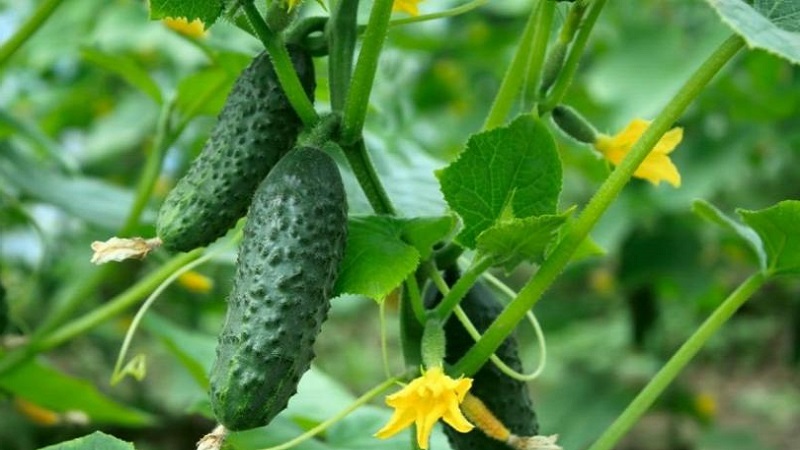
The fruits of this variety are bright and crispy. They have a sweet taste and rich cucumber aroma.
Variety resistant to cold snaps... It is grown outdoors in the central and southern parts of our country.
Competitor has persistent immunity to disease melons and gourds. He is not even afraid of powdery mildew, which often affects cucumbers.
The negative features of the variety include susceptibility to dry weather. Under such conditions, the fruits wither quickly and acquire a bitter taste.
Useful properties of the variety
Cucumber Competitor is 95% water. Its fruits are considered dietary... There are only 14 kcal per 100 g of product.
Fruits have a number of beneficial properties:
- Alkaline compounds in the composition slow down the aging process of the body, prevent the formation of liver and kidney stones.
- Easily assimilated iodine compounds have a beneficial effect on the thyroid gland and cardiovascular system.
- Fiber improves intestinal peristalsis and removes toxins from the body.
- Folic acid is especially beneficial for pregnant women. It ensures the correct development of the fetus.
- Chlorophyll activates cellular respiration, improves the general condition of the body.
- Potassium normalizes blood pressure and eliminates puffiness.
Cucumbers contain vitamins B, C and A, phosphorus, iron, zinc, manganese, sodium, zinc, copper. This combination of micro- and macroelements helps to rejuvenate the body, cleanse it from harmful substances, optimize brain activity, strengthen the gums and teeth.
About other varieties and hybrids of cucumber:
Early hybrid of cucumbers "Grasshopper"
General characteristics
Cucumber Competitor - an old variety, but loved by domestic summer residents. is he yields tasty small cucumbers and is able to grow in unprotected soil not only in the southern, but also in the central regions.
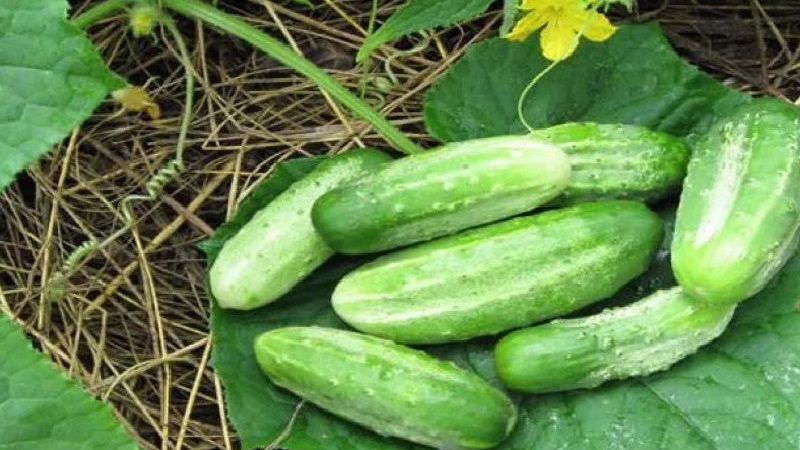
Description and characteristics of the variety:
| Parameters | Indicators |
| Bush type | Indeterminate, long-leaved plant. The length of the lashes exceeds 2 m. The ground part is medium branched. The leaves are large, dark green with pubescence. The length of the stalk is 7 cm. On the bush, approximately the same number of female and male inflorescences is formed. |
| Fruit | Small ones. Length varies within 8-12 cm. Weight is 80-120 g. The shape is elongated. The color is dark green with yellow-green stripes that cover two-thirds of the length of the cucumber. Tubercles with dark spines are present on the surface. The taste is sweet, with a rich cucumber aroma. The skin is firm. The seeds are covered with a fairly dense shell. The pulp is crispy and juicy. |
| Yield | Average. From 1 sq. m collect up to 5 kg of fruit. |
| Ripening terms | Medium early. The first crop is harvested 45-50 days after sowing the seeds. |
| Growing method | In the central and southern regions, they are grown outdoors. In cities with a cold climate, they are cultivated in heifers. |
| Transportability | High. The fruits have a dense skin that allows them to be transported over long distances and stored for up to three weeks. |
| Disease resistance | It is resistant to the main diseases of cucumbers. |
It is interesting! Competitor's inflorescences open at 4-6 hours. After that, the pollen remains viable for two hours. After 12-14 days, the flowers fall off.
How to grow this variety yourself
Competitor cucumbers are grown both in greenhouses and in the open field... At the same time, on the street, the yield indicators will be higher.
Cucumbers cannot stand the scorching sun. Shaded areas of the garden are chosen for them. The shadow is also created artificially, planting tall crops on both sides of the beds.
In the place where the Competitor will grow, no other melons and gourds should be cultivated during the previous two years. In greenhouses, it is enough to replace the top layer of the soil; in the open ground, new beds are selected for plants.
Pay attention to the right neighborhood... Melons are not planted next to cucumber beds. The culture gets along well with root crops and nightshade plants.
The cucumber beds are started in the fall. They are dug up and cleaned of all plant residues. The soil is mixed with rotted chicken droppings, crushed plant residues, treated with a light pink solution of potassium permanganate, or humus at the rate of 6 kg per 1 sq. m.
Cucumbers love slightly acidic soils. If this indicator is increased, dry lime is added. Sand is used to loosen the soil.
In the spring, the beds are leveled with a rake and cleared of weeds. For 1 sq. m make 25 g of superphosphate and 15 g of urea. The beds are watered with a hot solution prepared from Art. l. copper sulfate and a bucket of water.
For the Competitor, a 40x40 cm landing pattern is used... For 1 sq. m fits up to five plants.
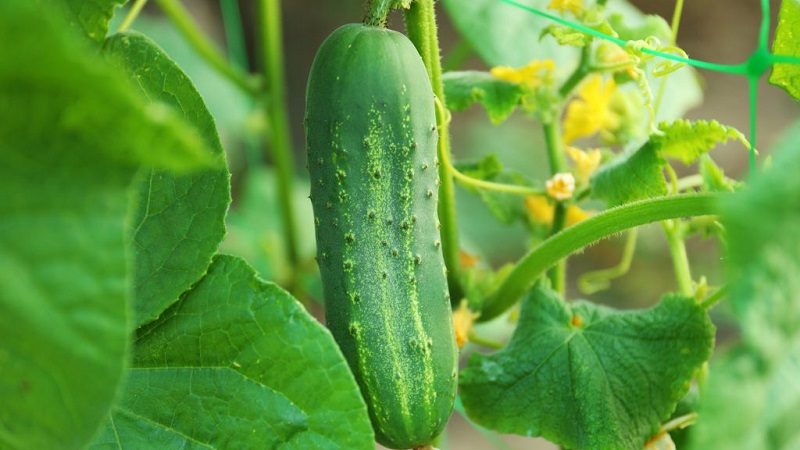
Landing
Cucumbers are grown by seed (in the southern regions) and seedlings. Both options are used with the same frequency. When growing seedlings, the harvest will appear faster.
Before sowing seeds, they are prepared... This is especially important if they were not processed in the factory or were harvested from their own harvest:
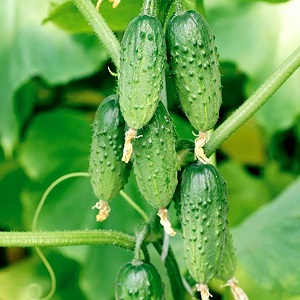 For planting, dense large specimens are chosen without damage and dark spots. They are soaked in warm water for three minutes.
For planting, dense large specimens are chosen without damage and dark spots. They are soaked in warm water for three minutes.- The seeds are immersed for 10 minutes in a solution prepared from a glass of water and 1 tsp. salt. The emerged specimens are thrown away, the ones that have sunk to the bottom are washed and work with them further.
- The planting material is disinfected. To do this, it is soaked for half an hour in a light pink solution of potassium permanganate or for 15 minutes in hydrogen peroxide. The seeds are washed again with warm water and dried with a towel.
- After that, they are wrapped in cloth or sent back to the packaging. They are placed in a warm place (on a battery) for 30 days.
- Stimulates seed germination.To do this, they are soaked in commercial preparations ("Epine") according to the instructions or in a solution of ash for 12 hours. The ash solution is prepared from 0.5 tbsp. l. ash and a glass of water.
- The processed seeds are wrapped in moist material and wait for it to bite.
- The nashed planting material is removed for four days in the refrigerator.
Note! Disinfection and testing of seeds for germination are considered mandatory. Some summer residents skip the rest of the stages - in this case, the germination rate will be lower.
By seed method
Cucumbers are grown in a seedless way only in the southern regions.... Seeds are sown in the ground in early June. The first crop in this case will be ready for harvest at the end of the month.
Before sowing the seeds, the wells are prepared. 5 cm of rotted manure and the same amount of earth are poured onto the bottom. Mix the ingredients thoroughly. The rest of the space is filled with garden soil.
Important! Dig holes for cucumbers 25 cm deep.
The beds are watered with warm water. Two seeds are sown in each hole, deepening them by 3 cm.

The beds are covered with foil, which is removed seven days after the seeds have germinated. Before that, they open it daily so that the seedlings are ventilated.
When the seeds germinate and two true leaves appear on them, pinch the weaker stem. It is important to break the plant, not uproot it, otherwise it will damage your neighbor's roots.
Read also:
Hybrid "Grandma's granddaughter f1": description and agricultural technology
Seedling way
The seedling method is suitable for all regions of Russia and allows you to get an early harvest. Seeds are sown for seedlings in late April.
The competitor's planting material is placed immediately in individual pots... It is more convenient to use peat containers, from which the plants are not removed during transplantation. Plastic containers 15 cm high with drainage holes are also suitable.
First, the containers are disinfected: they are soaked for half an hour in a dark pink solution of potassium permanganate.
The soil for cucumber seedlings should be light and nutritious. It is prepared from equal parts of garden soil, humus and half a portion of sand.
At the bottom of the pots, 2-3 cm of drainage (sand, broken ceramics) must be covered.
The soil and drainage are disinfected. To do this, they are calcined in the oven or watered with a dark pink solution of potassium permanganate.
In each container, one seed is sown to a depth of 4 cm. The containers are covered with foil and removed to a warm place. When the seeds germinate, the containers with the seedlings are rearranged on the windowsill, and the film is removed.
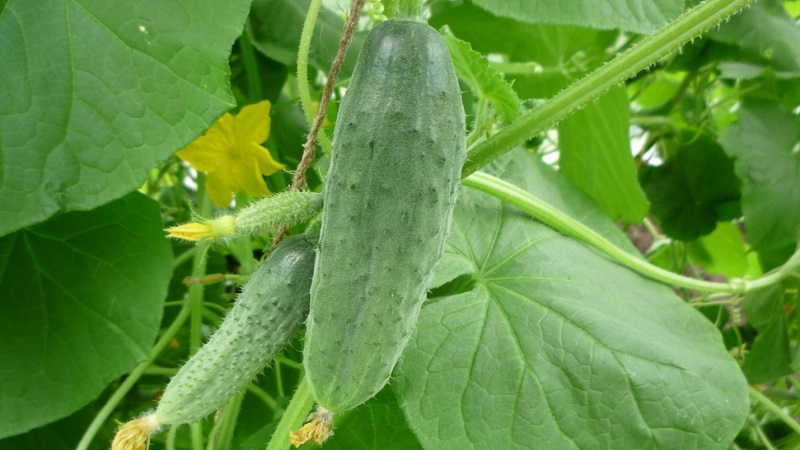
When growing seedlings, it is important to observe the following rules:
- The soil is moistened with a rain method as it dries. Use warm water.
- If the leaves turn yellow, this means that the cucumbers lack light. A fluorescent lamp will help to compensate for its lack.
- When two real leaves appear, the seedlings are fed. It is poured with a solution of nitrophoska (1 tsp per 1 liter of water).
- A week before disembarking the seedlings to a permanent place, they begin to take it out into the street in a warm time of the day. The hardening procedure will help the plants to take root after the pick.
- Two days before planting seedlings in a permanent place, it is watered.
Three weeks later (second half of May), cucumbers dive to a permanent place. They are transplanted into holes along with a lump of earth, without deepening the root collar.
A liter of water is poured under each bush. Then add 25 g of nitrophoska. The first two weeks, the beds are covered with foil to prevent the death of plants due to frost.
Growing and care
Cucumbers Competitor must be tied up, for example, to trellises or any vertical objects. Many people install a structure over the garden bed, assembled from an arc of thick wire. A whip is thrown over it.
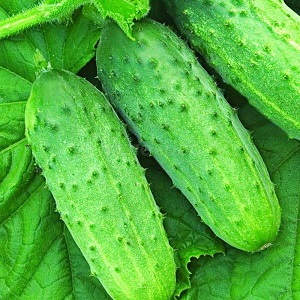 To get a good harvest, cucumbers stepchild... This is done in the following way:
To get a good harvest, cucumbers stepchild... This is done in the following way:
- In the first four axils of the leaves, all stepsons and ties are removed.This is necessary for airing the bush and forming a powerful root system.
- In the fifth and sixth nodes, two ovaries are left. All stepsons are removed.
- After the sixth and seventh leaves, all stepchildren and ovaries are left. The lashes are pinched after the first sheet.
- All ovaries are left in the upper part of the plant, pinching them after the second or third leaf.
- When the plant outgrows the support, the stem is wrapped around the post three times. It is lowered 80 cm and pinched.
Water the cucumbers daily... After this procedure, the soil is loosened and cleaned of weeds.
Top dressing is applied at least three times during the entire growing period... A solution of chicken manure (1:10) is alternated with superphosphate (25 g per bucket of water) and urea diluted in water (10 liters of water and 1 tbsp. L. Urea).
Useful tips for growing
Tips from experienced gardeners to help you get a rich harvest and avoid many problems. Here are some of them:
- If the fruits are bitter and curved, then the plants lack potassium. The same problem occurs when there is insufficient watering.
- To help plants adapt more easily after picking to a permanent place, they are sprayed with Epin solution. The same technique is used for cold snaps.
- Spraying the bushes with nitrophos will increase the number of ovaries.
- To attract pollinating insects, the bushes are sprayed with sweet water. This will also increase the number of ovaries.
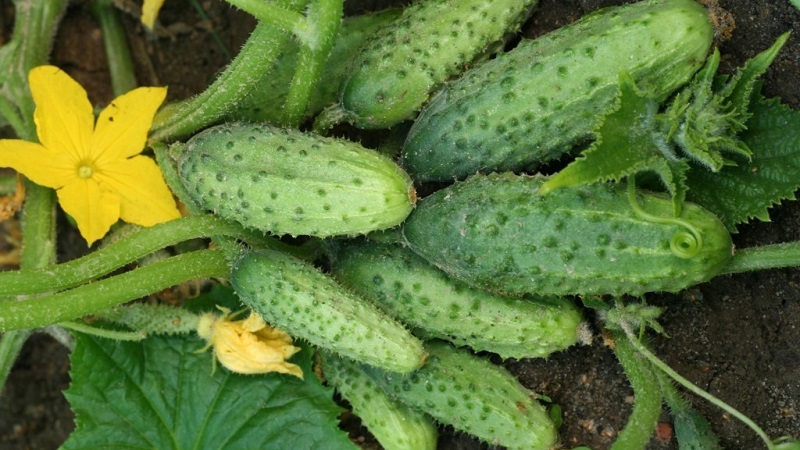
Diseases and pests
Competitor is highly resistant to diseases of melons... You just need to follow the rules for caring for plants.
It is important to protect plants from peststhat carry infections and damage bushes. To do this, use purchased preparations ("Barrier") or homemade products (tobacco powder, soap solution for spraying, wormwood decoction, pepper tincture).
Harvesting and application of the crop
The first cucumbers are ready for harvest in mid-June... They are plucked as soon as the length reaches 8-12 cm. If you overexpose the fruits on the bush, they will turn yellow, become non-aromatic and tough.
Cucumbers Competitor used for fresh consumption and preparations for the winter... They remain firm and crunchy in brine.
Competitor's advantages and disadvantages
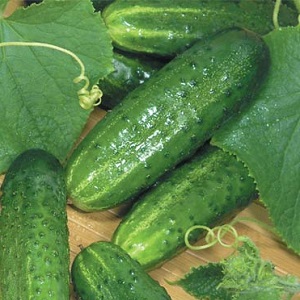 The advantages of the variety:
The advantages of the variety:
- high productivity;
- cold resistance;
- transportability and keeping quality of the crop;
- immunity to diseases of melons;
- the possibility of cultivation in a greenhouse and open field;
- the possibility of using seeds from the harvested crop for sowing.
The disadvantage is the need garter and scrub formation of the Competitor.
Reviews
Reviews about the Competitor are mostly positive. This is an old and proven variety that is popular with beginners and experienced gardeners.
Vitaly, Lipetsk: “I have been raising a competitor for over 10 years. An excellent variety that will never let you down. Not afraid of diseases and small cold snaps. The main thing is to pinch and water on time. Cucumbers in this case will turn out sweet and crispy ".
Sonya, Voronezh: “I took the Competitor's seeds from a neighbor. Not a bad variety. Didn't get sick. I liked the cucumbers. They are delicious and crunchy. Suitable for pickling and pickling. I recommend to everyone".
Conclusion
Cucumbers Competitor is one of the most popular varieties in Russia. It was bred more than 40 years ago, but gardeners still love it. He is not afraid of diseases and is easy to care for.
The Competitor's fruits are small in size, taste great and have a cucumber aroma. This variety is good both fresh and marinated.